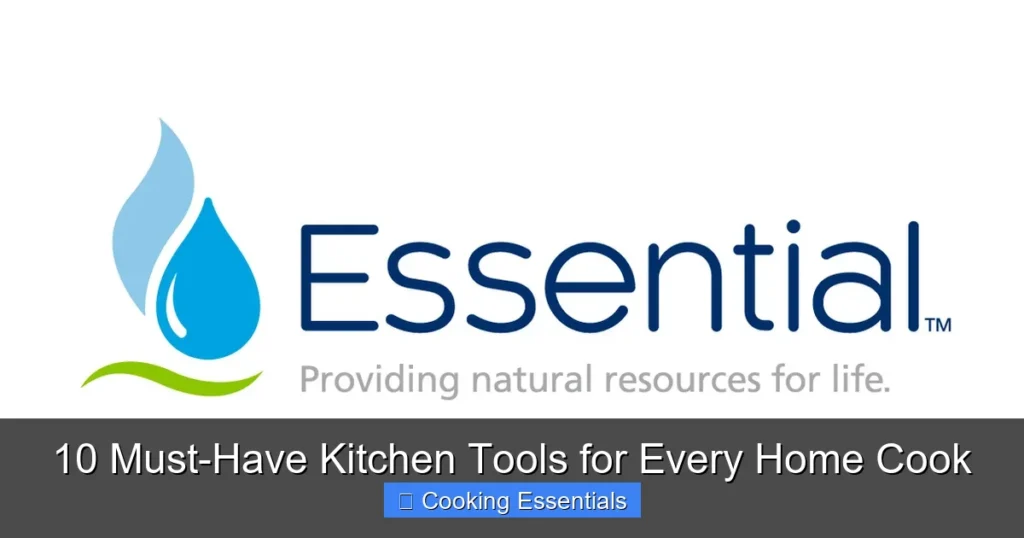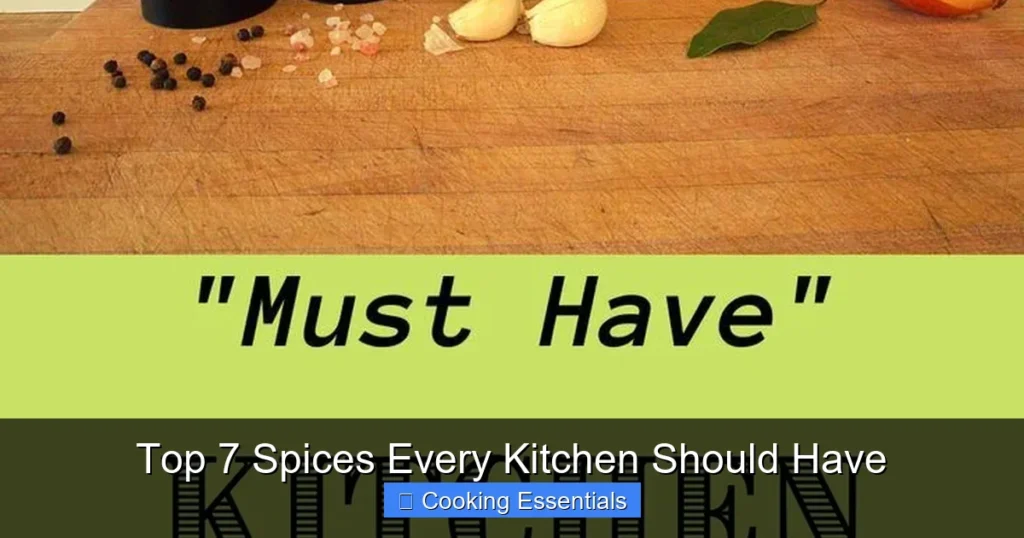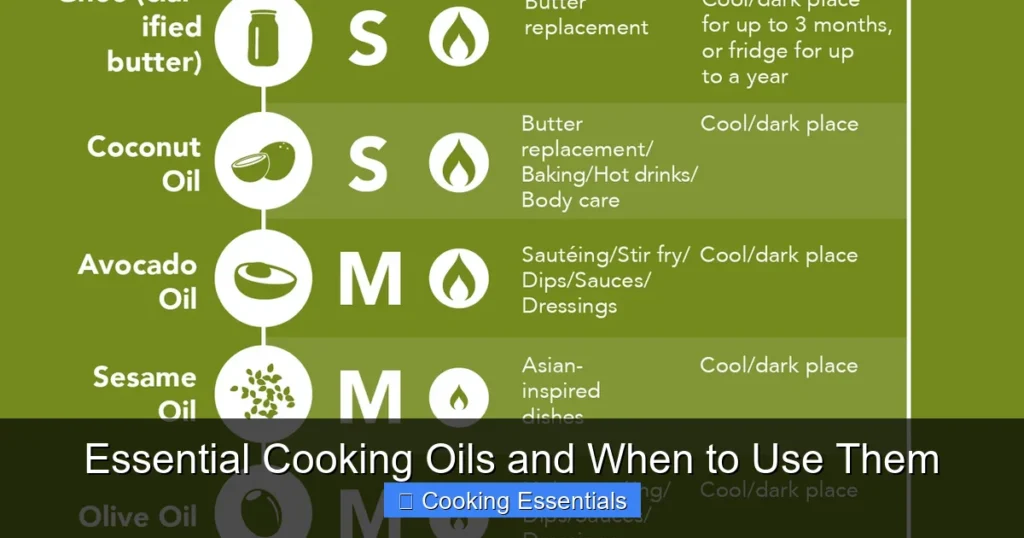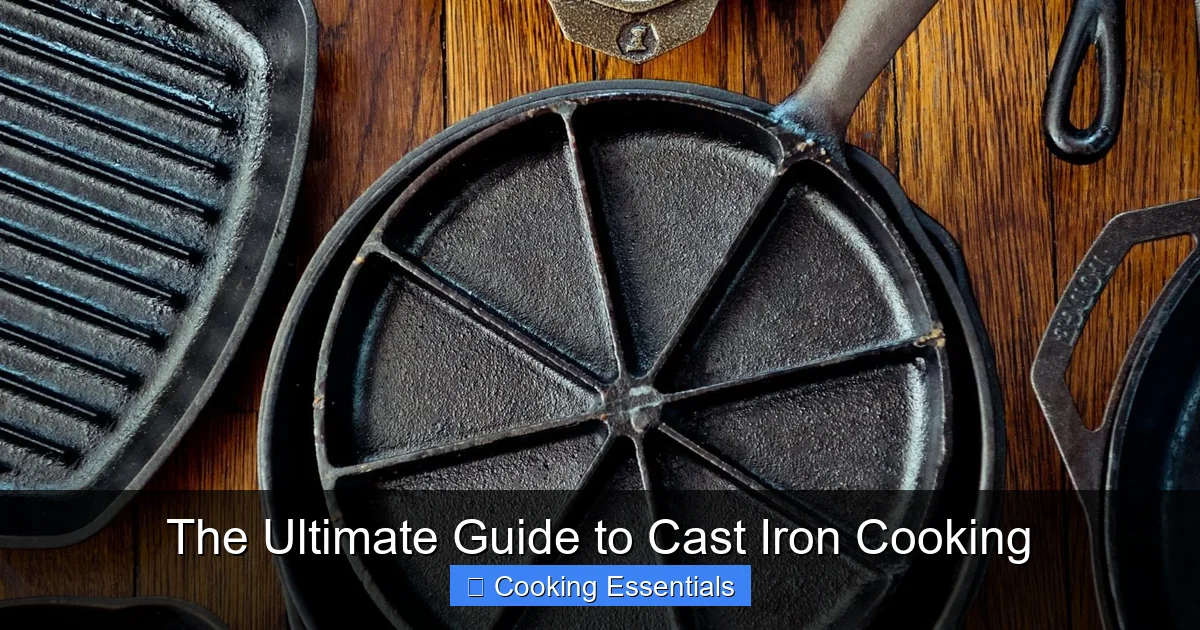
Featured image for this comprehensive guide about cast iron cooking guide
Image source: i.pinimg.com
The Ultimate Guide to Cast Iron Cooking
Category: Cooking Essentials
Are you ready to transform your culinary adventures? Imagine a single piece of cookware that can sear a steak to perfection, bake a fluffy cornbread, and even fry an egg with minimal oil, all while getting better with age. Welcome to the world of cast iron cooking! For generations, cast iron has been a cornerstone in kitchens worldwide, revered for its durability, versatility, and unparalleled cooking performance. Yet, many home cooks are intimidated by this timeless tool, often due to misconceptions about its care and use.
This comprehensive cast iron cooking guide is designed to demystify everything you need to know, from selecting your first skillet to mastering the art of seasoning, cleaning, and cooking like a pro. Whether you’re a seasoned chef or a complete beginner, prepare to unlock the full potential of your cast iron cookware. We’ll dive deep into the benefits, offer actionable tips, and equip you with the knowledge to make your cast iron an indispensable part of your kitchen arsenal for years to come. Let’s embark on this delicious journey together!
Quick Answers to Common Questions
Why should I even consider cast iron cooking?
Cast iron offers incredible heat retention and distribution, making your food cook evenly and deliciously. Plus, with proper care, it can become naturally non-stick and last for generations!
Do I really need to “season” my cast iron pan?
Yes! Seasoning creates a natural, non-stick surface by baking thin layers of oil onto the pan, protecting it from rust and making your cast iron cooking experience much smoother. It’s key for building that beautiful patina.
Can I use soap to clean my cast iron, or will it ruin the seasoning?
Absolutely, modern dish soaps are fine and won’t strip your hard-earned seasoning! Just make sure to dry your cast iron thoroughly on the stovetop and apply a very light coat of oil afterwards.
What’s the secret to keeping food from sticking to my cast iron pan?
The trick to successful cast iron cooking is proper preheating and enough fat! Always preheat your pan thoroughly before adding food, and don’t skimp on a little oil or butter to help things glide smoothly.
What kinds of dishes are best for my new cast iron cooking adventure?
Cast iron excels at high-heat searing for steaks, frying up crispy chicken, baking cornbread, and even making delicious skillet pizzas. It’s incredibly versatile, so get ready to experiment!
📋 Table of Contents
- Why Choose Cast Iron? Unveiling the Benefits
- Understanding Your Cast Iron: Seasoning Demystified
- The Art of Cooking with Cast Iron: Tips and Techniques
- Cleaning and Maintaining Your Cast Iron: A Step-by-Step Guide
- Troubleshooting Common Cast Iron Issues
- Expanding Your Cast Iron Arsenal: Must-Have Pieces and Recipes to Try
- Conclusion: Embrace the Legacy of Cast Iron Cooking
Why Choose Cast Iron? Unveiling the Benefits
In a world saturated with non-stick coatings and specialized pots, why does cast iron cooking continue to stand the test of time? The answer lies in its unique properties and numerous advantages that elevate the cooking experience.

Learn more about cast iron cooking guide – The Ultimate Guide to Cast Iron Cooking
Image source: amainsider.com
Durability That Lasts Generations
Unlike other cookware that might scratch, warp, or wear out over time, cast iron is virtually indestructible. Many cast iron pieces are passed down through families, becoming cherished heirlooms that have seen decades, even centuries, of use. With proper care, your cast iron skillet will likely outlive you, making it an incredibly sustainable and economical investment.
| Cooking Aspect | Cast Iron Trait | Key Best Practice | Benefits / Notes |
|---|---|---|---|
| Heat Retention | Excellent; distributes heat evenly | Preheat slowly over medium heat for 5-10 mins | Prevents hot spots; ideal for searing, frying, baking. Maintains temp even after food is added. |
| Non-Stick Surface | Develops naturally with proper seasoning | Maintain seasoning; avoid harsh soaps & metal utensils on new seasoning | Healthier cooking with less oil; improves with each use. Not a chemical coating like PTFE. |
| Cleaning & Care | Requires specific, gentle cleaning | Scrape food, use hot water & stiff brush (mild soap if needed). Dry immediately. Re-oil lightly. | Prevents rust; preserves seasoning. Never soak or put in dishwasher. |
| Durability & Longevity | Extremely robust; can last for generations | Avoid extreme thermal shock (e.g., hot pan in cold water) | A “buy it for life” essential; great heirloom piece. Virtually indestructible with proper care. |
| Versatility | Suitable for multiple heat sources and cooking methods | Safe for stovetop, oven, grill, campfire. (Handle may get hot!) | Perfect for searing steaks, frying eggs, baking cornbread, deep-frying chicken. One pan for many tasks. |
Superior Heat Retention and Even Cooking
Cast iron excels at holding and distributing heat evenly. Once it’s hot, it stays hot, making it ideal for searing meats, frying, and baking. This even heat distribution prevents hot spots, ensuring your food cooks uniformly and develops that coveted crispy crust or golden-brown finish.
Naturally Non-Stick (Once Seasoned Properly!)
One of the most appealing benefits of a well-maintained cast iron pan is its natural non-stick surface. This isn’t a factory coating but a layer of polymerized oil – known as seasoning – that builds up over time with use and proper care. The more you cook with it, the better the non-stick properties become, reducing your reliance on excess oils and unhealthy chemical coatings.
Versatility Beyond Compare
From stovetop to oven to campfire, cast iron can handle it all. You can use it to:
- Sear steaks and chops
- Fry eggs and bacon
- Bake cornbread, pizzas, and even cakes
- Roast vegetables
- Simmer stews and chilis
- Deep fry chicken
Its ability to transition seamlessly between cooking methods makes it an incredibly versatile tool in any kitchen.
Potential Health Benefits
While not a primary reason for choosing cast iron, cooking with it can subtly increase the iron content in your food. Studies have shown that foods cooked in cast iron cookware can absorb a small amount of dietary iron, which can be beneficial, especially for individuals with iron deficiencies.
Understanding Your Cast Iron: Seasoning Demystified
The term “seasoning” is perhaps the most misunderstood aspect of cast iron cooking. It’s not about adding spices; it’s about building a protective, non-stick layer on your cookware. This section of our cast iron cooking guide will clear up all the confusion.
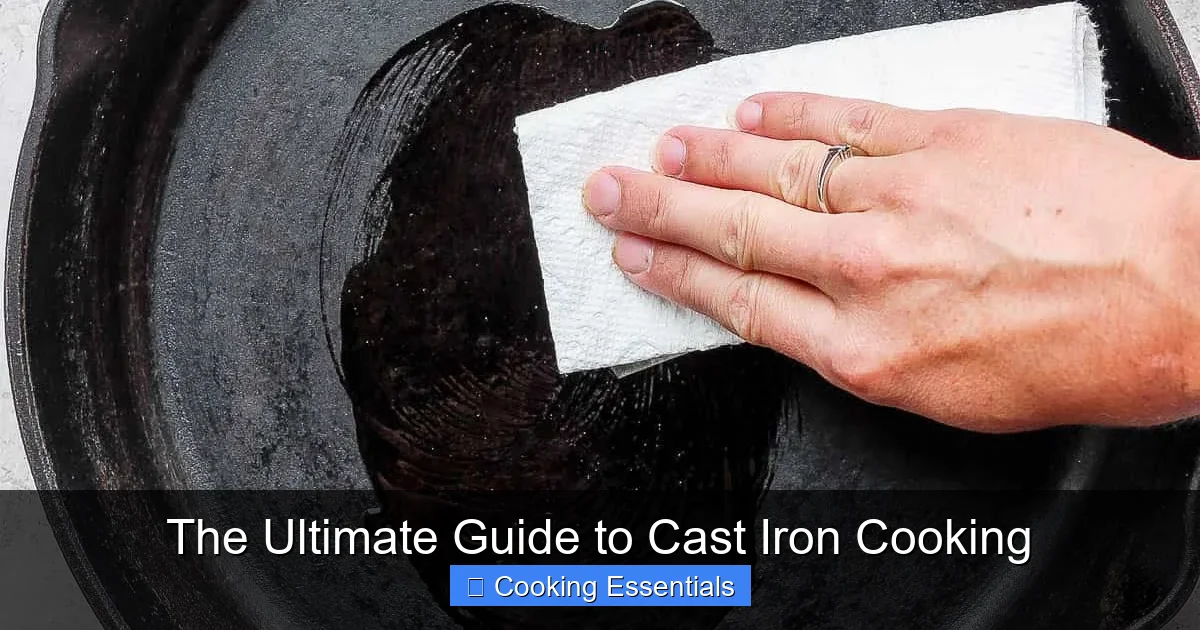
Learn more about cast iron cooking guide – The Ultimate Guide to Cast Iron Cooking
Image source: feelgoodfoodie.net
What is Seasoning?
Seasoning is essentially a layer of polymerized oil that has been baked onto the surface of your cast iron. When oil is heated past its smoke point, it breaks down and bonds with the metal, creating a slick, hardened, non-stick surface. This layer protects the cast iron from rust and provides that desirable non-stick quality.
Initial Seasoning for New Pans
Many modern cast iron skillets come “pre-seasoned” from the factory, which is a great start. However, a little extra seasoning at home can further enhance its performance. If you have an unseasoned pan (or an antique), you’ll need to do a full initial seasoning:
- Clean Thoroughly: Wash the pan with warm, soapy water and a stiff brush to remove any manufacturing residue. Dry immediately and completely.
- Apply Oil: Apply a very thin, even layer of high smoke point oil (like grapeseed, flaxseed, or vegetable oil) to the entire surface of the pan, inside and out. Use a paper towel to wipe off any excess – you want it to look dry, not greasy. Too much oil will result in a sticky, gummy finish.
- Bake It: Place the pan upside down on the middle rack of a preheated oven (375-450°F / 190-230°C). Place aluminum foil or a baking sheet on the bottom rack to catch any drips.
- Bake Again: Bake for one hour. Turn off the oven and let the pan cool completely inside the oven.
- Repeat: For best results, repeat this process 3-5 times. The more layers, the stronger the seasoning.
Maintaining and Re-seasoning
Every time you cook with oil and heat your cast iron, you’re essentially adding to its seasoning. However, sometimes the seasoning can be stripped (e.g., by acidic foods or harsh scrubbing) or damaged. If your pan starts to rust, food sticks more often, or the surface looks dull and uneven, it’s time to re-season. Follow the same steps as initial seasoning, focusing on the affected areas or the entire pan if needed. Consistency is key to great cast iron care.
The Art of Cooking with Cast Iron: Tips and Techniques
Now that you understand seasoning, let’s get to the fun part: cooking with cast iron! These tips will help you achieve perfect results every time.
Preheat Slowly and Thoroughly
One of the golden rules of cast iron cooking is patience. Cast iron takes longer to heat up than other pans, but it retains that heat exceptionally well. Place your pan on medium-low heat and let it preheat for 5-10 minutes. This slow preheat ensures even heat distribution across the entire cooking surface, preventing hot spots and ensuring your food cooks uniformly. A properly preheated pan is crucial for a good sear and prevents sticking.
Use the Right Amount of Oil
Even with a perfectly seasoned pan, you’ll still need some oil or fat, especially for dishes that aren’t inherently greasy. Add a thin layer of oil or butter after the pan is preheated. The oil helps create a barrier between the food and the cooking surface, further enhancing non-stick properties and contributing to better browning.
Avoid Overcrowding the Pan
Just like with any pan, overcrowding cast iron can steam your food instead of searing it. Cook in batches if necessary to maintain a consistent pan temperature and achieve that desirable crispy exterior.
What to Cook (And What to Avoid, Especially Early On)
- Cook This:
- Meats: Steaks, chicken, pork chops, bacon, sausages (perfect for searing and getting a crust).
- Baked Goods: Cornbread, biscuits, frittatas, pizzas, even cakes (even heat is fantastic).
- Fried Foods: Eggs, fried chicken, hash browns, pancakes.
- Vegetables: Roasted potatoes, stir-fries.
- Avoid (Especially with New Seasoning):
- Highly Acidic Foods: Tomatoes, wine sauces, citrus juices can strip away seasoning, especially on newer pans. While a well-seasoned pan can handle some acidity, it’s best to limit long simmering of acidic dishes until your seasoning is robust.
- Delicate Fish: Can sometimes stick more easily, especially if the pan isn’t perfectly seasoned.
Cleaning and Maintaining Your Cast Iron: A Step-by-Step Guide
Proper cast iron care is essential for its longevity and performance. Forget what you’ve heard about never washing it with soap; modern soaps are milder than their lye-based predecessors and won’t harm your seasoning if used sparingly.
Immediate Cleaning is Key
Clean your cast iron pan immediately after use, while it’s still warm (but not scorching hot). This makes cleaning much easier.
The Cleaning Process:
- Scrape Food: Use a wooden spoon, plastic scraper, or a dedicated cast iron chainmail scrubber to remove any stuck-on food bits.
- Rinse and Scrub: Rinse under warm running water. For stubborn bits, you can use a tiny amount of mild dish soap and a brush or sponge. Scrub gently. Avoid abrasive steel wool pads unless you’re trying to strip the pan for a full re-seasoning.
- Rinse Thoroughly: Ensure all soap residue is gone.
- Dry Immediately and Completely: This is the most crucial step to prevent rust. You can hand dry with a clean towel, or better yet, place it on a burner over low heat for a few minutes until all moisture evaporates. Listen for the sizzle; when it stops, it’s dry.
- Apply a Thin Oil Layer: Once dry and still warm, apply a very thin coat of cooking oil (vegetable, grapeseed, or flaxseed) to the entire cooking surface and a little on the outside. Buff it in with a paper towel until it looks dry and non-greasy. This protective layer is vital for maintaining seasoning and preventing rust.
Storage Tips
Store your cast iron in a dry place. If stacking multiple pans, place a paper towel between them to absorb any moisture and protect the seasoning.
Troubleshooting Common Cast Iron Issues
Even with the best intentions, you might encounter some challenges. This section of our cast iron cooking guide addresses common problems and their solutions.
Issue 1: Food is Sticking
Cause: Insufficient seasoning, pan not preheated enough, or not enough oil.
Solution: Ensure your pan is well-seasoned. Preheat your cast iron slowly on medium-low heat for 5-10 minutes before adding food. Always use a small amount of oil or fat when cooking. If sticking persists, consider giving your pan a few extra seasoning cycles.
Issue 2: Rust Spots
Cause: Moisture exposure, inadequate drying after washing, or stripped seasoning.
Solution:
- Scrub the rusty area with steel wool or a stiff brush until the rust is gone.
- Wash thoroughly with soap and water to remove rust particles.
- Dry completely and immediately.
- Apply several thin layers of seasoning as described earlier. Prevention is key: always dry thoroughly and apply a thin oil coat after each wash.
Issue 3: Sticky, Gummy, or Uneven Seasoning
Cause: Too much oil applied during seasoning, oil not buffed off sufficiently, or seasoning at too low a temperature.
Solution:
- If minor, continue cooking with the pan; over time and with proper usage, the sticky spots will usually polymerize.
- For more severe issues, scrub the gummy areas (you might need a little soap and a scraper) until smooth.
- Wash, dry completely, and then re-season, ensuring you apply an extremely thin layer of oil and buff it until it looks dry before baking. Increase the oven temperature slightly if necessary (up to 450°F / 230°C) to ensure the oil polymers properly.
Issue 4: Dull or Dry-Looking Pan
Cause: Lack of regular use, not enough oil applied after washing, or seasoning thinning out.
Solution: Continue using your pan! Each time you cook with oil, you build seasoning. After each wash and dry, apply that crucial thin layer of oil. If it looks very dry, a full re-seasoning session in the oven can help revive its luster.
Expanding Your Cast Iron Arsenal: Must-Have Pieces and Recipes to Try
Once you’ve mastered the basics, you might find yourself wanting to expand your cast iron cookware collection. Different pieces offer unique advantages for various cooking tasks.
Essential Cast Iron Cookware Pieces
Here’s a look at some popular cast iron essentials and their primary uses:
| Cookware Piece | Description & Primary Use | Ideal For |
|---|---|---|
| Cast Iron Skillet (10-12 inch) | The most versatile and common piece. Perfect for frying, searing, baking, and roasting. | Steaks, eggs, cornbread, frittatas, pan-frying, oven baking. |
| Dutch Oven (5-7 quart) | Heavy, deep pot with a lid. Excellent for slow cooking, braising, baking bread, and deep frying. | Stews, chilis, pot roasts, soups, no-knead bread, deep frying. |
| Griddle/Grill Pan | Flat surface (griddle) for even heating, or ridged surface (grill pan) for grill marks. | Pancakes, bacon, grilled sandwiches, burgers, indoor grilling. |
| Baking Pan (e.g., cornbread, muffin) | Specialized shapes for baking. | Cornbread muffins, individual desserts, sweet or savory bakes. |
| Wok | Traditional wok shape for stir-frying at high heat. | Stir-fries, deep frying, steaming. |
Simple Recipes to Get Started with Cast Iron
Ready to put your newfound knowledge to the test? Here are some beginner-friendly ideas to build up your pan’s seasoning and confidence:
- Perfect Seared Steak: Preheat your skillet until very hot, add a high-smoke-point oil, then sear your steak for a few minutes per side until a beautiful crust forms. Finish in the oven if desired.
- Fluffy Cornbread: Preheat your skillet in the oven while mixing your cornbread batter. Pour the batter into the hot, oiled skillet for an incredibly crispy crust.
- Pan-Fried Chicken Thighs: Season chicken thighs and cook skin-side down in a medium-hot, oiled skillet until crispy, then flip and finish cooking through.
- Roasted Vegetables: Toss your favorite veggies with oil and seasonings, then roast in a hot cast iron pan in the oven until tender and caramelized.
Conclusion: Embrace the Legacy of Cast Iron Cooking
Congratulations! You’ve navigated the ultimate cast iron cooking guide and are now equipped with the knowledge and confidence to master this incredible piece of cookware. Remember, cast iron cooking is not just about preparing meals; it’s about connecting with a rich culinary tradition, creating delicious memories, and investing in a tool that will serve you faithfully for decades.
Don’t be afraid to experiment, and don’t get discouraged by minor setbacks like a little rust or sticky spots – they’re all part of the learning process. With consistent care, proper seasoning, and a little love, your cast iron skillet will quickly become your most cherished and versatile kitchen companion. So, go ahead, heat up that skillet, and savor the unique flavors and unparalleled performance that only cast iron can deliver. Happy cooking!
🎥 Related Video: This is how I like to season and eat a cast iron pan. WASH with little soap afterwards! #cookingtips
📺 Jose.elcook
Frequently Asked Questions
How do I properly season my cast iron pan?
Seasoning creates a natural, non-stick surface and protects your pan from rust. To season, apply a very thin layer of high smoke point oil (like flaxseed or grapeseed) to a clean, dry pan, then bake it upside down in an oven at 400-450°F (200-230°C) for an hour. Let it cool completely before using.
What’s the best way to clean cast iron after cooking?
After cooking, while the pan is still warm, scrape off food bits with a stiff brush or pan scraper. For stubborn residue, you can use a small amount of mild soap and water, then rinse thoroughly and immediately dry the cast iron pan completely over low heat on the stove. Finish with a very thin layer of oil.
Can I cook acidic foods in cast iron cookware?
While occasional use of acidic foods like tomato sauce is generally fine with a well-seasoned cast iron pan, prolonged simmering can strip the seasoning. It’s best to avoid cooking highly acidic dishes for extended periods, especially in newly seasoned or poorly seasoned cast iron cookware.
Why is my food sticking to my cast iron skillet, and what can I do?
Food often sticks to cast iron due to insufficient seasoning, using too low a temperature, or not enough cooking oil. Ensure your cast iron skillet is well-seasoned, preheat it thoroughly before adding food, and always use adequate cooking fat.
How often should I re-season my cast iron?
The frequency of re-seasoning your cast iron depends on how often you use it and how well you maintain it. If your seasoning looks dull, food starts sticking more often, or you notice light rust, it’s a good indicator that it’s time for a full re-seasoning. Regularly drying and lightly oiling after each wash also helps maintain the existing seasoning.
Is it true you can’t use soap on cast iron?
The old myth that you can’t use soap on cast iron dates back to when soaps contained harsh lye, which would strip seasoning. Modern mild dish soap is perfectly fine for cleaning cast iron and won’t harm a well-established seasoning. Just remember to always dry your pan immediately and thoroughly after washing.
